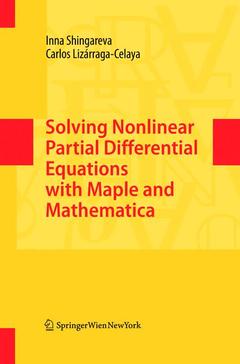Solving Nonlinear Partial Differential Equations with Maple and Mathematica, 2011

1 Introduction 1.1 Basic Concepts 2 Algebraic Approach 2.1 Point Transformations 2.2 Contact Transformations 2.3 Transformations Relating Differential Equations 2.4 Linearizing and Bilinearizing Transformations 2.5 Reductions of Nonlinear PDEs 2.6 Separation of Variables 2.7 Transformation Groups 2.8 Nonlinear Systems 3 Geometric-Qualitative Approach 3.1 Method of Characteristics 3.2 Generalized Method of Characteristics 3.3 Qualitative Analysis 4 General Analytical Approach. Integrability 4.1 Painlevé Test and Integrability 4.2 Complete Integrability. Evolution Equations 4.3 Nonlinear Systems. Integrability Conditions 5 Approximate Analytical Approach 5.1 Adomian Decomposition Method 5.2 Asymptotic Expansions. Perturbation Methods 6 Numerical Approach 6.1 Embedded Numerical Methods 6.2 Finite DifferenceMethods 7 Analytical-Numerical Approach 7.1 Method of Lines 7.2 Spectral Collocation Method; A Brief Description of Maple A.1 Introduction A.2 Basic Concepts A.3 Maple Language B Brief Description of Mathematica B.1 Introduction B.2 Basic Concepts B.3 Mathematica Language; References, Index
Date de parution : 10-2014
Ouvrage de 357 p.
15.5x23.5 cm
Date de parution : 07-2011
Ouvrage de 357 p.
15.5x23.5 cm
